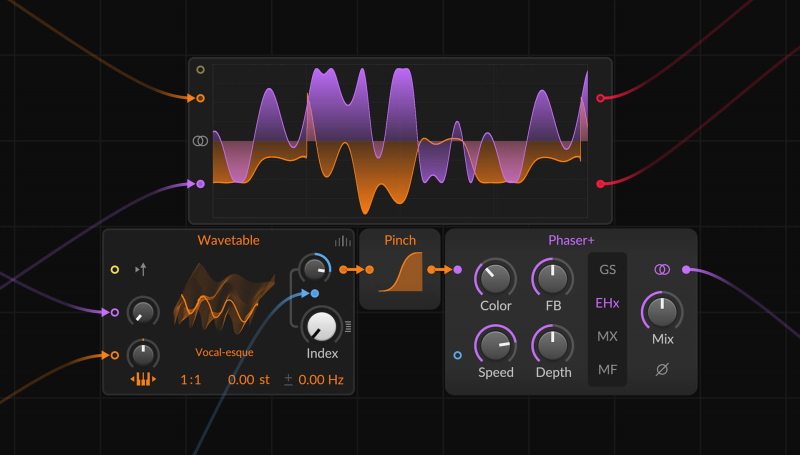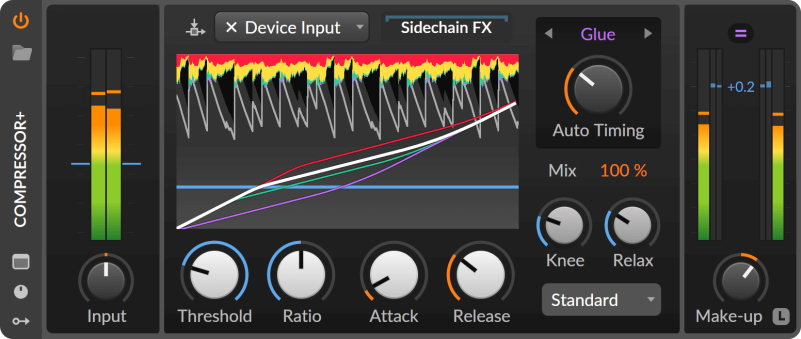Bitwig Studio 5.2

Bitwig Studio 5.2 is out now. This Bitwig Studio update comes with a new set of studio tools: with a new set of studio tools: a professional compressor (Compressor+) that brings a unique approach to dynamics, three hardware-inspired EQs (Focus, Sculpt, and Tilt), a clipper device called Over. There are also significant workflow enhancements, including more precise editing, dynamic beat detection and hardware acceleration for our graphic interface.
Compressor+ is an all-in-one compressor for any use case. Its combination of familiar with unusual controls and its superior approach to analyzing audio make it excel at adding color and tone as well as mastering.
Six Characters engage different styles of compression by changing various gain reduction and envelope behaviors and numerous "under the hood" settings.
- Vanilla (the default character) applies parameters literally, including Attack and Release times going all the way down to zero.
- Smooth uses slow perband response, offering miimal distortion.
- Over tends compress more quickly, but in a stable way.
- Glue is slow to engage and quick to release, making it good for transient preservation on the mix buss or anywhere else.
- Resist has longer envelopes and tries to quickly snap back afterward to preserve bass and add even harmonics when pushed.
- Smash over-accelerates the attacks and releases and uses the Auto Timing control to further increase acceleration.
The special Auto Timing control is the amount that timing parameters (Attack, Release, and more) are automatically adjusted to suit the incoming audio. Taken together, the combination of the Character choice and Auto Timing setting offers a wide sonic variety.
Compressor+ analyzes incoming audio across four frequency bands, which are shown on the device's colorful display and in the expanded view. Fold it out to access each band's Intensity and Timing offsets in order to fine-tune which parts of the signal cause compression. So if you want the bass to trigger less, just decrease its band's Intensity. Or if your settings are a little tight on the vocals, try increasing the Timing offset for the hi-mids.
The device comes with three modes that determine the compressor’s behavior:
- Standard compressor mode is the default, that offers a normal range of compressor ratio settings.
- Beyond has an extended compressor range, adding under- and over-compression options by replacing Ratio with a Ratio Extended control.
- Dual is the mode for upwards compression. It lifts quieter signals too by replacing the Knee control with a Lift parameter, which smoothly moves through the custom curves for bumping the signal below the threshold.
The output section of the compressor is stocked with different VCA Colors:
- Clear (the default) applies no coloring.
- Prism gives a clean blend of true multiband compression, with unified single-band compression.Transistor provides a consistent analog feel, with a low bump and slightly reduced highs.
- Saturate has a moving analog feel, like tape saturation, with a mid-range bump and some frequency-dependent behavior.
"Compressor+ is super flexible. It combines features from different types of compressors from analog and digital worlds. It packs them into a one-stop shop where you can dial everything quickly and flick between different types of harmonic distortion or envelope behaviors. You can use the excellent presets or very quickly dial in the tones you need." - Yoad Nevo, mastering engineer (Ed Sheeran, Sia, Pet Shop Boys)

In Bitwig Studio 5.2 a new trio of EQs inspired by classic hardware - Focus, Sculpt, and Tilt - bring a natural musicality to the task of shaping sound. Sculpt inherited the controls and components of the renowned Pultec EQP-1, a vintage broadband EQ good for bass sweetening and more, using preset frequency choices to quickly dial in magic. But the choice of saturation is left to you, from the matching Tube style, to Transistor for even harmonics and mid-range punch, or even a clinically Clean model. Focus took the same approach to recreating the choices and components of the mid-range-oriented MEQ-5. After tuning those sonic "power" regions, similar saturation choices are a click away. Tilt's simple interface lets you re-balance any sound to be brighter or darker, with additional choices for the center Frequency and how steep the Slope is. A Stereo-ize option is available in all three EQs for effectively duplicating the unit and then tilting it a variable Amount in the Stereo field (to push up frequencies and gain in the left or right channel), or to apply in the mid-side domain.
When working in any of the timeline editors, Bitwig Studio has two ways of making a selection. Each method has its own unique functions and keyboard workflows, so it is also possible to Switch between selection kinds in the Edit menu.
- Object selection starts with choosing one or more timeline objects (such as clips, audio events, note events, expression points, or automation points). This is usually achieved by clicking objects with the Pointer tool. The computer keyboard's arrow keys default to whatever makes sense in each particular case - for making selection (with clips and points), or for moving events (with notes and audio events) - but the alternate case is available via the [ALT] key.
- Time selection captures any events (or partial events) within a span of time. This is usually achieved with the Time Selection tool. Clicking into an editor with this tool selects a single moment of time, which then allows the computer keyboard's arrow keys to jump between significant events (such as audio onsets, or note starts and ends). This allows quick, precise editing right from the Arranger, or at any other level. captures any events (or partial events) within a span of time. This is usually achieved with the Time Selection tool. Clicking into an editor with this tool selects a single moment of time, which then allows the computer keyboard's arrow keys to jump between significant events (such as audio onsets, or note starts and ends). This allows quick, precise editing right from the Arranger, or at any other level.
Now with Bitwig Studio 5.2 the arrow keys can now send you between relevant points of interest in clips or on the Arranger Timeline, or even between different tracks in the project. Cruise the Arranger Timeline via small increments like beat divisions, automation points, clip starts and ends and more. Jump from the beginning to the end of notes within their clips, or from transient to transient in audio clips. Make a selection - of notes, clips, events, etc. - across one or more tracks. And you can do all this without leaving the keyboard.
Speaking of quality-of-life improvements, 5.0's better onset detection bears fruit this update in ways that streamline working with different tempos. You can trust Bitwig Studio to accurately warp long audio files for you - even those with variable tempos will stay on track. Onset analysis happens when audio is dragged into a project, as does beat detection, which determines where beats occur within the audio.
Alternatively, your project can adapt to the clip's time, bringing new conveniences to the process of making DJ mixes, podcasts, or adding production to long recordings. Your project can adopt an audio clip's tempo as a static value with Set Current Tempo, or apply its timing changes as an automation curve on the global tempo with the Apply Tempo Curve To Arranger command.
Bitwig also rewrote their graphics engine to be more responsive and efficient. Painting their interface on your computer's GPU gives them native hardware acceleration, and more CPU is now available for your audio. Also, knobs pop more and scopes have a fresh look. Drawing in general has been highly optimized as well, running fewer commands and giving springier results. So whether you just have high track counts and thousands of events or you are fond of quick zooming and editing, you will be covered. On all three platforms.
A few new ideas appeared while designing our new sound design tools.
- Over is a boutique clipper that harnesses multiband, oversampling, and a slot for wet-only effects. So add a nice crispy crust to any sound, or just burn it down.
- The Chain device also got its own Learn Wet Gain option, giving you a perfectly configured Mix knob for blending any audio effect chain, including plug-ins.
- The Grid now has Crossover-2 and Crossover-3 modules in the Mix category.
- Additionally, Multi-Note got its own Chord Learn function for immediate programming and playback.
- The FX Selector device earned crossfade timings so you can fine-tune your transitions. And for programming synth structures, the variable Shift Register module and simple All-pass might help you out.
- Plug-in Undo allows you to quickly undo changes applied to third-party plug-ins. So no matter what you change, Bitwig can always bring you that critical one step back.
Bitwig Studio 5.2 is a free upgrade for all Bitwig Studio license holders with an active Upgrade Plan as of announcement (April 25, 2024). Please note that 5.2 has updated system requirements. Starting with this version, you'll need at least Windows 10, macOS 10.15 or later, and Ubuntu 22.04 or later. And for graphics, on Windows you'll need DirectX 11 or higher, and on Linux, DX11-level Vulkan.
 How to resolve AdBlock issue?
How to resolve AdBlock issue?